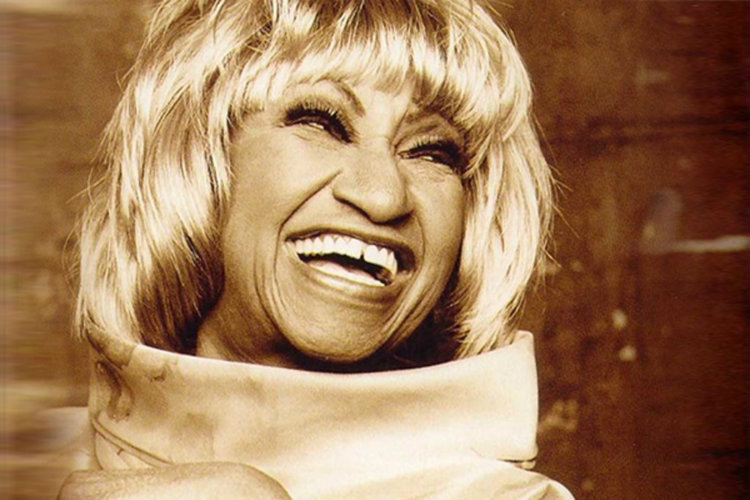It’s time we talked about the Queen of Salsa, Celia Cruz. Born in Havana in 1925, Cruz garnered 23 gold records before passing away in 2003. In addition to the popular moniker The Queen of Salsa, people also know Cruz as The Queen of Latin Music. She’s a powerhouse, and not just because of her amazing sense of style.
A search for Celia Cruz on Spotify yields pages and pages of seemingly unlimited scrolling through “best of” recordings, salsa compilations, and album titles that ooze enigma: Inolvidable, De Cuba Traigo el Sabor, Celia, Celia la Reina, Celia Cruz Eterna, Alma Con Alma, and infinite variations on that wavelength. Indeed, the singer is credited with over 70 albums, claims the Celia Cruz Foundation. That lady got it done.
A good starting block is the “Popular” section on her Spotify artist page, where you’ll find the salsa rendition of an old standby, “I Will Survive — “Yo Viveré.” Hit play and you’ll be swept away, not only by the phenomenal piano, clave, and orchestral composition — which provide intricacy and texture rather than just support — but by the richness of Cruz’s voice. It’s velvety, deep, acrobatic. It’s almost androgynous. Mingled with the background vocals, which provide punchy call-and-response vibes, Cruz’s voice is both playful and grand.
I find myself thinking of Cruz as a Latina version of one of my personal favorites, Aretha Franklin, who’s big-band songs like “RESPECT” and “Chain of Fools” my dad used to blast on Sunday mornings to get me out of bed when I was a teenager. Both women are energetic and have rich voices, but Cruz was born nearly 20 years before Franklin. And frankly (hehe), I find Cruz’s music to be a bit more adventurous. I love many different kinds of music, but it’s really hard to beat salsa’s vibrant energy. It sounds like a party that, in an era where romantic music topped the charts, seems to come before its time.
Growing Up Celia
Cruz grew up poor in Havana and began attending school to become a teacher at her father’s request, even though she had already begun receiving recognition for her singing in her teens. Her success with live and radio performances quickly propelled her to Havana’s National Conservatory for Music, where she was encouraged to drop out and pursue a professional career.
Cruz made her first recordings in 1948, and then began singing with Sonora Matancera, an acclaimed Cuban orchestra, where she faced criticism and doubt from a standard array of nay-saying sexists who thought a female salsa musician could never appeal to a wide audience. Of course, she proved them wrong, and the group traveled across Latin America and eventually to the United States. When Fidel Castro came to power, she and her husband, Pedro Knight (Sonora Matancera’s trumpet player), decided to stay in the United States. This so angered Castro that he barred their re-entry.
Note: there are some discrepancies about the order of operations in her defection from Cuba. Britannica.com seems to think that she left because of the lack of nightlife and downgrade in quality of life after communists took over Cuba, while Biography.com makes it sound like she was already traveling around Latin America when Castro took over — and that she and Knight simply made the choice not to return home.
Becoming the Queen
In the US, Castro began a longtime collaboration with Tito Puente, a Puerto Rican – American musician with an established orchestra and a much larger following across Latin America. As the front woman, her charisma displayed itself in a flamboyant wardrobe, rich vocals, and a stage presence that ignited audience participation.
However, says Britannica, it wasn’t until Cruz began making salsa music in the early 70s that she really became widely known in the United States. She and Tito switched to Vaya Records, and she recorded a hit record with Johnny Pacheco, Celia y Johnny. As she quickly became a salsa staple in NYC and around the world, she also recorded several albums in the 70s and early 80s with another prominent American salsa musician, Willie Colón.
Why Celia Was Magical
Melinda Machado writes for the Smithsonian in 2012: “The thing about Celia Cruz was that she re-invented herself at every opportunity, always gaining new and younger fans.” That is to say, she was a risk-taker. She loved to wear headdresses and was known for shouting “Azucar!” to her live audiences. From her flamboyant attire, to her infectious smile, to her smart business decisions and her vim and vigor, Cruz was a vibrant and strong woman who didn’t allow cultural roadblocks like gender, familial obligations, and financial circumstance to hold her back.
Cruz recorded right up until her passing in 2003, and her last album, Regalo del Alma, received a posthumous award for best Salsa/Merengue Album of 2003. Despite the fact that Cruz recorded the album while battling brain cancer, her voice exudes the same power and energy that was her trademark during her entire career. One hit song from the album, “Ella Tiene Fuego,” recorded in collaboration with rapper Bandolero, exemplifies Cruz’s ability to diversify, and is a must-listen.
For more info about our lady, check out the 2008 doc, Celia: The Queen. I’ll do the same and report back!


Leave A Reply